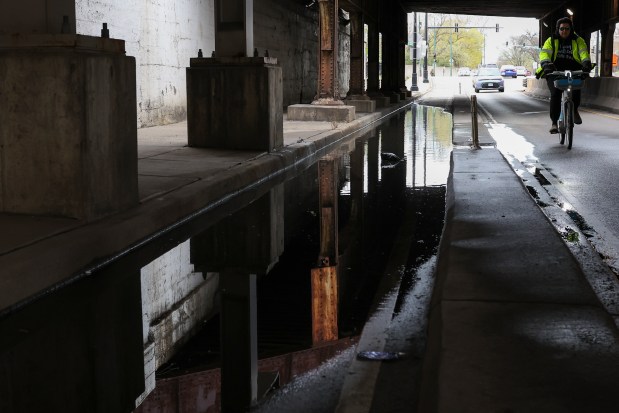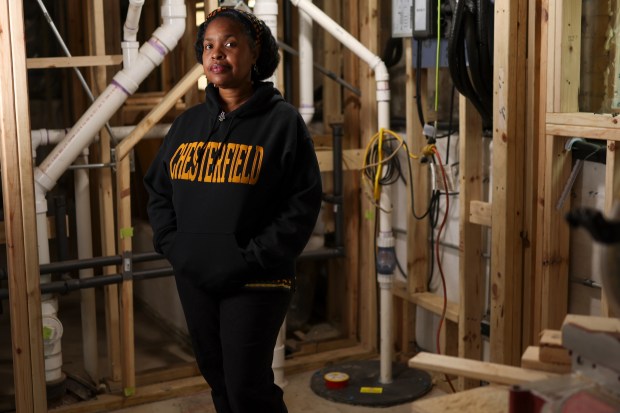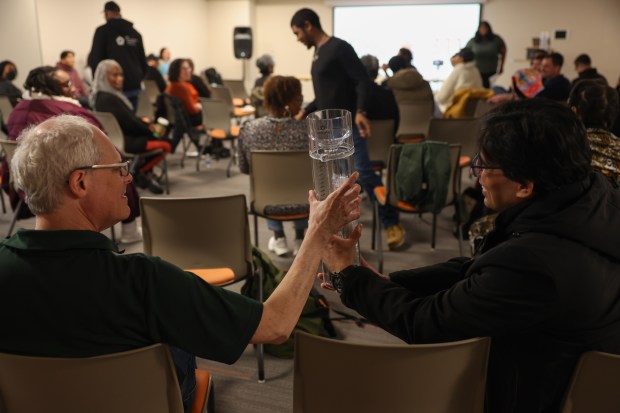When Nedra Sims Fears was growing up in Chatham in the 1960s and ’70s, the basement of her family home flooded at least six times.
Twice, the water rose so high that it triggered an electrical fire and her family had to move out during extensive renovations. Mementos from Fears’ early years — in a close-knit neighborhood that embraced hard work, education and block parties — were lost forever.
“We really just don’t have that many memories,” Fears said. “Most things, if it wasn’t waterlogged, it was smoke-damaged. My daughter found a picture of me as a child — and there’s not many of them.”
Now Fears is fighting back, as part of a coalition of community leaders, university scientists and concerned citizens who have joined together to answer a question that has haunted this South Side neighborhood for decades: Why is it that Chatham experiences some of the worst basement flooding in the city?
Volunteers are measuring rainfall in their yards, a local nonprofit is rallying support, and scientists at universities including the University of Illinois, Chicago State and Northwestern are gathering data with soil moisture sensors, radar, weather balloons, and groundwater probes.
The scientists are participating as part of the Department of Energy’s five-year, $25 million Community Research on Climate and Urban Science (CROCUS) project, which aims to better understand and predict urban weather challenges in Chicago, including heat waves and flooding.
Similar programs have faced threats of defunding during President Donald Trump’s cost-cutting campaigns.
“Normal weather models don’t incorporate urban dynamics particularly well, so we’re using new families and types of models — including machine learning and artificial intelligence-type models — which have never been operated at the scale needed to really capture what’s happening in cities,” said Max Berkelhammer, associate professor of earth and environmental sciences at the University of Illinois Chicago.
The scientists approached Fears, who said she jumped at the chance to get involved. Humboldt Park, West Woodlawn and the Metropolitan Mayors Caucus are also partnering with the scientists.
At a recent community meeting, the kickoff for a Chatham flooding app created by University of Chicago students, Fears told the crowd that working with researchers will allow the community to propose evidence-based solutions, raise money from funding sources and advocate for effective government action.
“This is the first time where we have a weather app — most communities don’t. (It’s the first time) that we have our land grant institutions and our HBCUs (historically Black colleges and universities) and our private universities coming together to collectively figure this out,” she said. “It’s like the cavalry is coming.”
Key driver
When it comes to basement flooding, rain is almost always a key driver. A big downpour can overwhelm the local sewer network, causing stormwater — and in some cases raw sewage — to back up through basement drains and toilets.
In another common form of basement flooding called foundation seepage, water enters the basements through cracks in the walls or floors, according to a 2017 report from the Center for Neighborhood Technology.
And, finally, water can enter a basement directly, through window wells or doors.

All three kinds of flooding happen in Chatham, along with street flooding, according to the report, which said the Chatham ZIP code 60619 had the most flood-damage claims in Cook County between 2007 and 2011. The ZIP code also ranked No. 1 for the total dollar amount paid out: $29 million.
The neighborhood’s other ZIP code, 60620, came in No. 4 among 169 ZIP codes for the number of claims, and No. 9 for the total dollar amount paid out.
At the recent Chatham community meeting, area residents spoke of the magnitude of the problem: One woman said she had to spend $40,000 to waterproof her basement.
“We have beautiful homes that we try to keep through generations, and yet we can’t get (flood) insurance,” another woman lamented.
Fears pointed to the broader implications for Chatham, a majority-Black neighborhood with a long history of achievement in business and the arts.
“It’s hard to create generational wealth when instead of updating your roof or putting in new windows, you are redoing the basement over and over and over again,” Fears said.

Berkelhammer, the UIC professor, showed the audience maps with patches of red highlighting areas of intense rainfall. The Northwest Side has both intense rainfall and flooding, as would be expected, he noted.
But that pattern fails on the South Side, which is a flooding hot spot without being a rain hot spot, indicating other forces are at work.
Among the causes of Chatham’s flooding problem named in the 2017 report: the city’s aging sewer system; the increase in pavement and buildings (which don’t absorb rain); Chatham’s low elevation; and climate change, which is contributing to an increase in severe weather events.
The report also pointed to Chatham’s “last in line” position in two different sewer systems, or networks of underground pipes that carry stormwater and household water out of the community for treatment.
Water from Chatham can be blocked from leaving the neighborhood if rain in downstream communities has already overwhelmed the sewer system, the report said.
“Right now we have two working theories,” Fears told the audience of about 40.
The first features the community’s two sewer systems. The second focuses on Chatham’s history as a low-lying wetland once known as Mud Lake or Hogs Swamp.
Fears recalled looking at a picture of the neighborhood from the 1890s.
“It was a pond, and I did not recognize anything,” she said. “And I remember as a girl that I saw ducks and geese on ponds as I walked to school. So, yes, it was a wetland, but half of Chicago is a wetland.”
She said she’s grateful to the scientists for taking a close look at a range of factors so explanations can move “from the anecdotal to the real.”
‘It was awful’
Chatham resident Lori Burns came away from the community meeting eager to do daily rain measurements in her yard.
Her own long battle with neighborhood flooding began after she moved into the classic brick bungalow that had belonged to her late grandparents.
Her basement flooded about five times between 2001 and 2013, due to sewer system backup, she said: “It was awful, horrible.”

Cleanup took hours over multiple days. First, there was the wait for the water to recede. Then she had to rinse everything down with brushes, mops and bleach.
“The flood in itself is extremely stressful and there’s physical danger involved and after that there’s the health repercussions from whatever’s in the water, and then the potential for mold,” said Burns, a business manager for a food broker.
“I’ve had to take time off work in order to clean up after a flood, so you’ve got lost wages,” she added.
Even after the waters were gone, there were lingering effects: “There’s a whole portion of your home that you don’t feel comfortable in. You don’t feel able to trust being able to use it like a living space because it’s not secure.”
Burns wants broader government fixes, such as sewer system upgrades, but, in the end, she didn’t wait for them.
In 2015, she invested in a backwater valve for the underground sewer pipe leading from her home to the street. Backwater valves are one-way flaps that allow wastewater to flow out of your home, but prevent it from flowing back in.
“I haven’t had a drop of sewage come back into my house since,” Burns said.
Burns also installed a rain garden with native plants such as milkweed to help soak up excess water, and she disconnected her downspouts, which reduces the amount of water flowing into the city sewer system during heavy rainfall.
In about 2018, she experienced a different type of water in the basement: seepage, in which water enters through cracks in the walls or floor. She put in a drain tile system and a sump pump, and the problem stopped, she said.
The combined solutions continue to work and her basement is dry, but the price was high — more than $20,000 in total — and she finds it frustrating that individuals have to bear the financial burden for fixing sewer system backflow, which she sees as a broader problem with government infrastructure.
Asked whether it’s an individual’s responsibility to prevent basement sewer backup flooding or the government’s, the Chicago Department of Water Management responded with a written statement.
“A resident can call 311 to report water in their basement. (The Department of Water Management) will send out an inspector to examine the sewer main that serves the area to determine whether it is flowing efficiently and order maintenance if it is not,” the statement said.
“The private sewer drain line is the responsibility of the homeowner,” the statement continued. “However, the City offers support services and has programs (for) residents when applicable.”
In a written statement, the Metropolitan Water Reclamation District of Greater Chicago pointed to sewer infrastructure improvements it has undertaken, such as the massive and ongoing Deep Tunnel Project, which serves communities including Chatham.
But the water district also noted the challenge of recent extreme weather events such as the series of storms on July 2, 2023, that dumped up to 9 inches of rain on the West Side and areas of Cicero, Berwyn and Oak Park.
“These storms demonstrate the need for additional investment in both gray and green infrastructure. … Few systems in the world could contain a storm of this magnitude,” the statement said.
Berkelhammer said that the scientific team’s work could be used by Chatham to push for specific sewer system fixes.
“I think we’re still working on how to present and articulate that but some of the modeling tools … will, I think, be able to provide some very specific information on that,” he said.
As for Burns, she said her dream is to have a clean, dry, comfortable basement — like her grandparents had when she was a girl. She remembers a second kitchen, space to play, even a second Christmas tree.
Asked if she’s finally achieved that goal, she responded, “I sure hope so.”
“There’s nothing else to do,” she said. “What else is there?”



